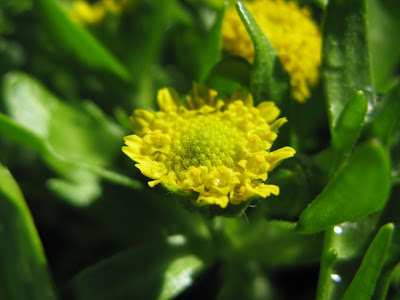The most common plant on SEFI is maritime goldfields (Lasthenia maritime), also known as "Farallon weed." This native spreading annual blankets the entire island, from the edge of the marine terrace to the lighthouse, with vivid green leaves and bright yellow flowers. It even grows on West End Island. Cassin's auklets dig their burrows underneath its canopy.
 Human visitors aren't the only animals on SEFI to appreciate the maritime goldfields. Sometimes on hot days the elephant seals will fling bits of the plant on their backs in an attempt to stay cool. In these photos, elephant seals lounge in the goldfields on
Human visitors aren't the only animals on SEFI to appreciate the maritime goldfields. Sometimes on hot days the elephant seals will fling bits of the plant on their backs in an attempt to stay cool. In these photos, elephant seals lounge in the goldfields on  the marine terrace.
the marine terrace.
Other common native plants include fiddleneck (Amsinckia spectabilis), with small, yellow, trumpet-shaped flowers that grow along a stalk like its namesake; miner's lettuce (Claytonia perfoliata), with tiny pale pink flowers in the center of a circular, glossy leaf; red maids (Calandrinia ciliata), whose flowers are a gorgeous deep purply red; and common chickweed (Stellaria media), a spreading, low-growing plant with a cluster of little white flowers. Another favorite is sticky sand spurry (Spergularia macrotheca), a succulent with fleshy thin linear leaves and purple or white flowers.
Non-native wildflowers grow on SEFI as well, including scarlet pimpernel (Anagalils arvensis), dwarf nettle (Urtica urens), goosefoot (Chenopodium murale), storksbill (Erodium moschatum and E. cicutarium), New Zealand spinach (Tetragonia expansa), and plantain (Plantago coronopus). One of the most common non-native plants is umbrella mallow (Malva neglecta), which sports a beautiful purple flower and big leaves. The U.S. Fish and Wildlife Service has been working to control both Malva and New Zealand spinach for 20 years, but the tenacious plants seem to have a strong foothold here.







4 comments:
The most common plant on SEFI is maritime goldfields (Lasthenia maritime), also known as "Farallon weed." This native spreading annual blankets the entire island, from the edge of the marine terrace to the lighthouse, with vivid green leaves and bright yellow flowers.Well Its location is very elegant.I think These plant's are use in Cough Syrups?Am i right?
Term papers
I really like this season, the flowers are beautiful, I would like to take some pictures of this place
Well. I am looking forward to reading more of your posts in the future. Thanks for your sharing.
Great informative post.. I am fully agree with your post.. It's really brilliant mind thought and superb for new generation.. Thank you guys for this cognitive post.
Post a Comment